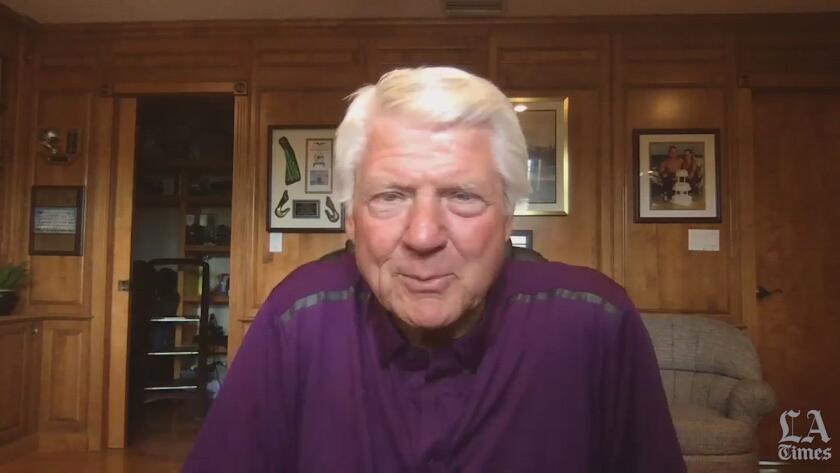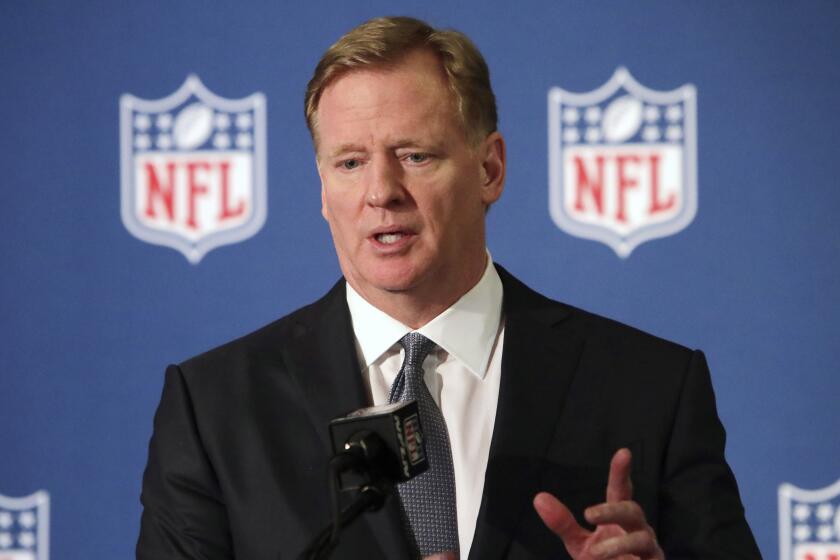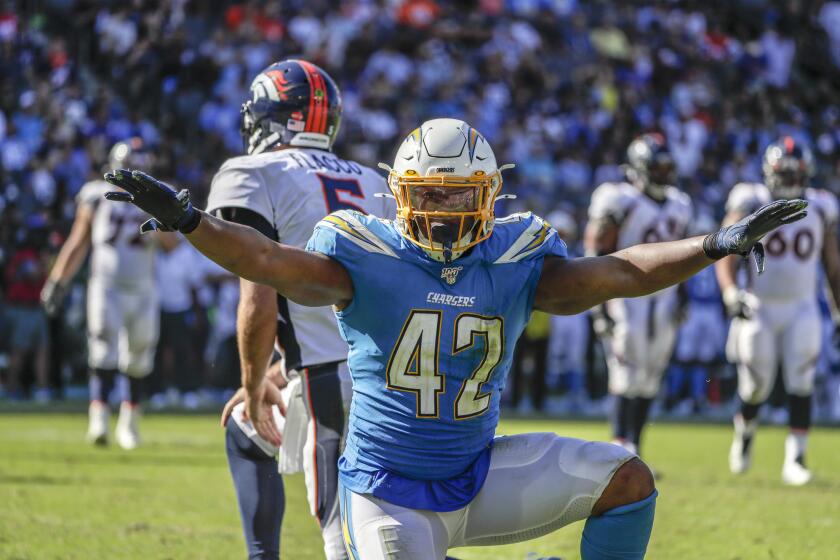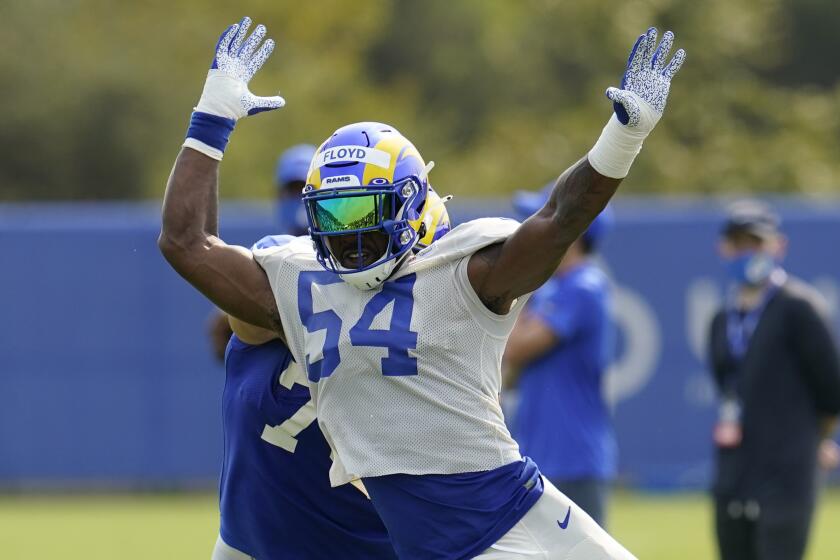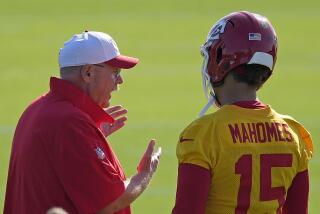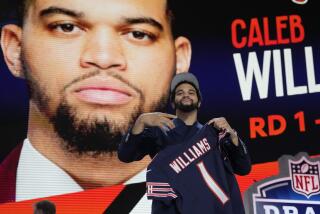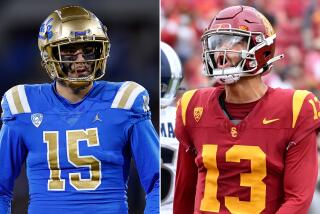Gaffes, gags, busy signals and a dog named Buttercup: Wacky NFL draft stories
- Share via
Former Dallas Cowboys and Miami Dolphins coach Jimmy Johnson shares his favorite NFL draft moments and how he developed a value chart to help him get Emmitt Smith and other players.
- Share via
The NFL will stage its annual draft in Cleveland this week, and despite the social distancing, video links to players in their homes and the like, a lot will be familiar.
There will be drama, hugs with the recently vaccinated commissioner, players pulling on the hats and jerseys of their new teams, and those agonizing waits in the green room.
“Draft time is not real time, it’s water-torture time,” said agent Leigh Steinberg, who has represented 62 first-round selections, eight of whom have gone No. 1 overall. “Every second is elongated like a minute, every minute an hour. The time between picks can be excruciating.”
But over the years, some of the behind-the-scenes stories of the draft are timeless. The gaffes, the gags, and the misunderstandings are the stuff of NFL lore. Some of the stories:
The NFL is lifting the constraints on its players who have been vaccinated for the COVID-19 virus.
Keep the line busy
Chuck Noll’s Pittsburgh Steelers sure knew how to dial up wins.
On draft day in 1984, they used an actual phone to do so.
That was back in the USFL days, so before NFL teams turned in their selection, they made a practice of touching base with their new player to make sure he hadn’t secretly signed with the rival league. So getting him on the phone was paramount.
Nobody had cellphones at the time, and call waiting was still foreign to a lot of people. If the person you were calling was already on the phone, you got a busy signal.
The Steelers were picking 23rd, and they had targeted Southern Mississippi receiver Louis Lipps. So nearly an hour before they selected him, they called Lipps, kept him on the phone and tied up the line in case somebody else wanted him.
Recalled Tony Dungy, the Hall of Fame coach who was Pittsburgh’s defensive coordinator at the time: “[Scout] Bill Nunn called him and said, ‘Hey, Louis, we’ve got about five picks to go and we want to draft you. If you want to come to the Steelers, all you have to do is stay on the phone.’”
Turned out to be a good call: Lipps was the NFL’s offensive rookie of the year and a two-time All-Pro.
The Chargers are counting on Uchenna Nwosu to be their edge rusher opposite star linebacker Joey Bosa.
Long wait
When Dungy was draft-eligible, it was he who was doing the calling.
It was 1977, and he was a safety coming out of the University of Minnesota. The draft wasn’t televised in those days, and Dungy was in his off-campus apartment waiting for word of which team had chosen him. And waiting.
Finally, confused and dejected, he picked up the phone and reluctantly called the Associated Press.
“I’m sorry,” said the person who answered the phone. “The draft has been over for a long time.”
Bad day for Dungy, but it all worked out. He signed as a free agent with the Steelers, and his NFL career was underway.
An eye for talent

Don Shula was so angry, he couldn’t see straight.
His Miami Dolphins had used a third-round pick on Virginia’s Terry Kirby in 1993, and only in the post-draft news conference did the coach learn that the running back had a vision problem.
A reporter asked Shula if he was worried about the rookie catching passes out of the backfield, considering Kirby had problems with his right eye. He had 20/40 vision out of that eye, although the NFL rumor mill had spun that into Kirby being “legally blind” on that side.
(Kirby went on to a respectable career of three seasons with the Dolphins, and seven more with San Francisco, Cleveland and Oakland.)
Whichever, Shula’s reaction in that news conference was essentially an eye chart: #@%!%!
As longtime Dolphins PR man Harvey Greene remembers it, Shula turned to Tom Heckert, the team’s player personnel director, and blurted: “Did we just draft a … blind guy?”
Something else flashed before Heckert’s eyes: his entire career.
Tipping the scales
Cleveland Browns owner Art Modell got quite a surprise after his team drafted Wisconsin cornerback Lawrence Johnson, among the fastest runners in the country, in the second round of the 1979 draft.
Per tradition, after the pick was official, a Browns assistant put the player on the phone with Modell.
Former team executive Kevin Byrne remembers the conversation thusly:
“Lawrence, this is Art Modell. Welcome to the Cleveland Browns. You’re our second-round selection.”
“Oh, my gosh! I had no idea I’d be drafted this soon. Some people told me I might be a free agent.”
NFL Network broadcaster Rich Eisen turned what was once a joke into a major philanthropic event with “Run Rich Run.” This year, he’s giving it a new twist.
“We’re glad to have you. It’s my understanding you’re one of the fastest guys around.”
“Well, I’m pretty fast for my size. I’ll be faster when I get my weight down.”
“How much do you weigh?”
“I’m at about 290 now.”
Aghast, the owner cupped his hand over the mouthpiece, turned to his coaches and whispered: “We drafted a corner who weighs 290 pounds?”
Whoops!
“The person who got Lawrence on the phone starts scrambling and he goes, ‘Wrong Lawrence Johnson!’” Byrne said. “He’s got an offensive tackle from somewhere in Wyoming.”
Fortunately for the Browns, they did actually draft the corner, and eventually got him on the phone.
Wrong Alex Smith
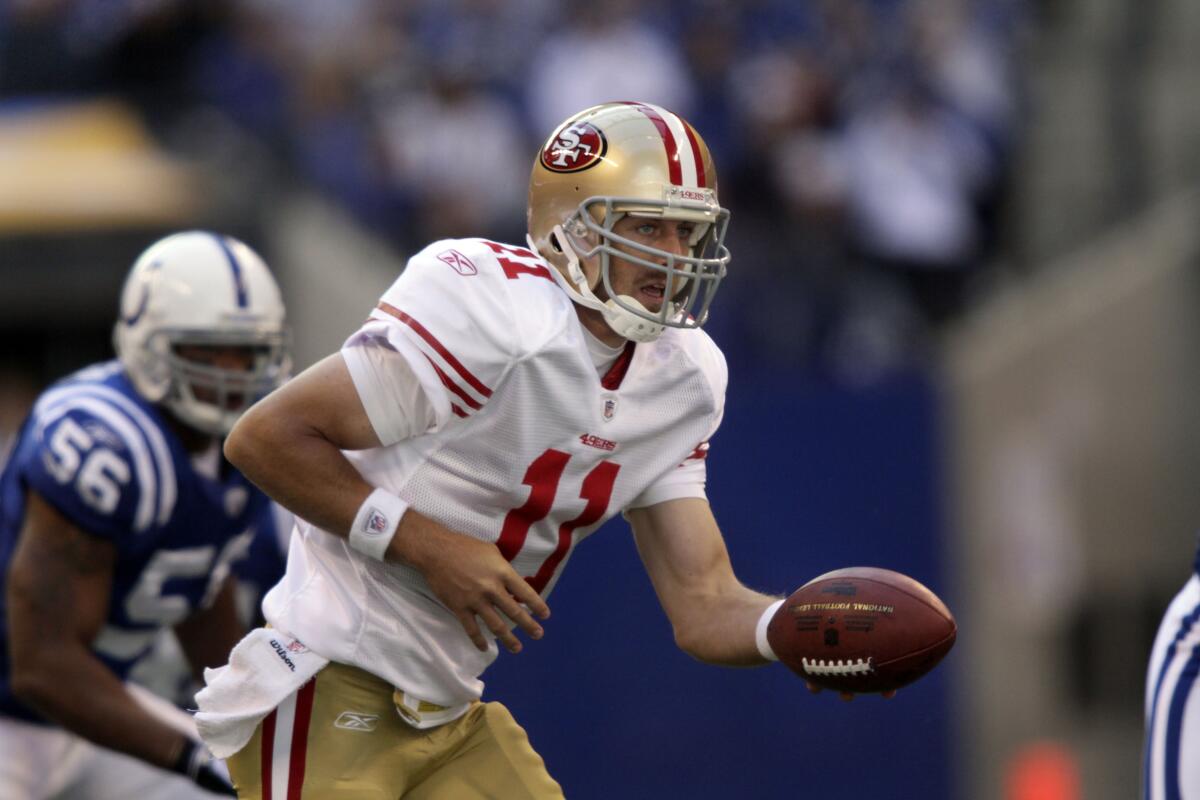
Sometimes, when it comes to two players with the same name, teams are interested in the other guy, the more obscure one.
That was the case in Detroit in 2005, when the Lions hoped to bring in to Stanford tight end Alexander Smith as one of their allotted 30 visits. Instead, they mistakenly flew in Utah quarterback Alex Smith, the eventual No. 1 pick of the 49ers.
“He shows up and I’m like, ‘What are you doing here?’” recalled Steve Mariucci, Lions coach at the time. “He’s like, ‘I don’t know.’ We were laughing. We didn’t have much to talk about other than catching up a little bit.”
Eventually, they called Smith’s uncle, John L. Smith, who was Michigan State’s football coach at the time. They all had a chuckle about the blunder.
The other Smith went to Tampa Bay in the third round.
Draft day shocker
The Lions used the 10th overall pick in 2005 to select USC’s Mike Williams, who was a beast of a receiver in college but struggled to keep his weight down in the NFL and never lived up to his potential.
He did have a sense of humor, however.
It’s common practice for draft picks to come to the team facility a day or so after they’re selected meet with coaches and have an introductory news conference. Williams was no different.
“We’re in the draft room on the next day of the draft, and he comes in on crutches,” Mariucci said. “Everybody was jaw to the ground like, ‘Whaaaaat?’”
It was a gag, and an effective one.
Pick up the phone
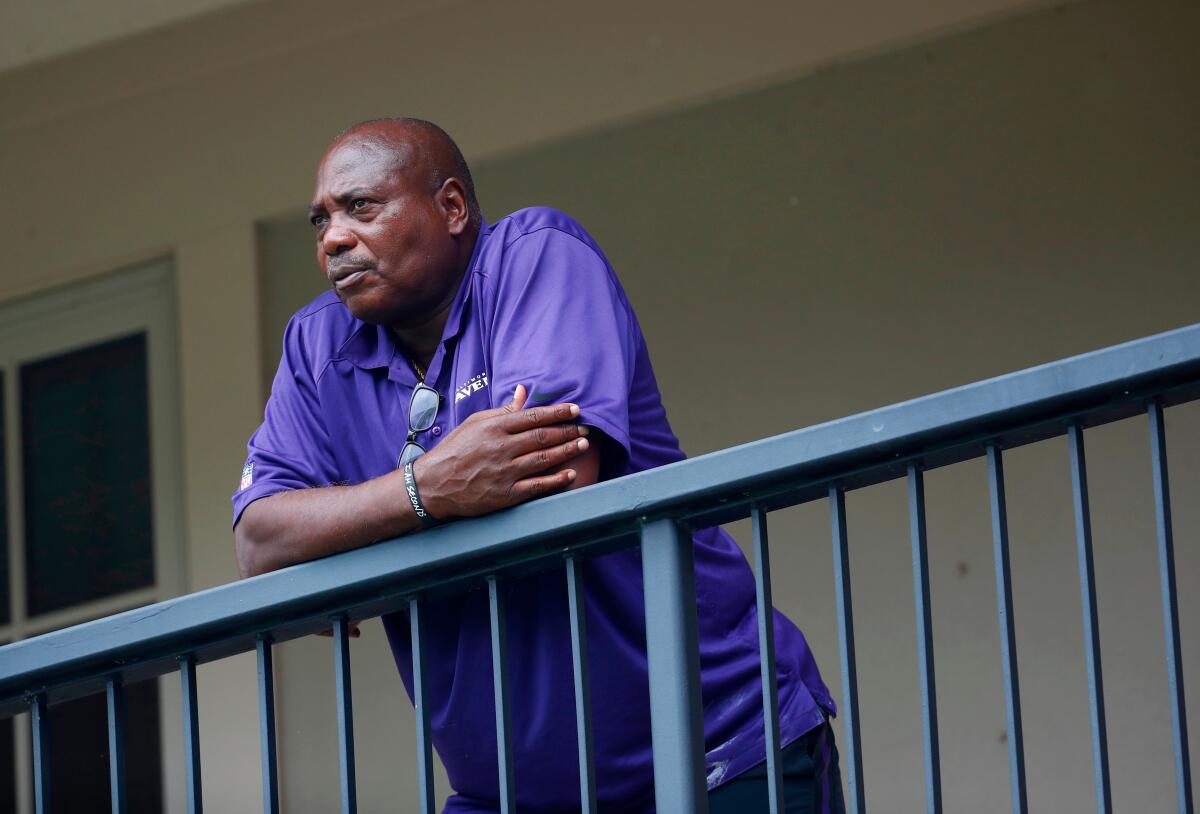
It’s pretty much essential to get a player or his agent on the phone before a selection becomes official. Otherwise, there are too many ways something can go wrong.
“It’s happened before where teams would draft guys and they’d be in jail,” said Ozzie Newsome, a legendary player then personnel executive. “Or maybe the guy got in a car accident the night before. Something strange could happen. So the practice was, before you turned the card in, you talked to the player. I took that practice from Cleveland to Baltimore.”
In 1996, their inaugural draft, the Ravens wanted to draft Maryland receiver Jermaine Lewis in the fourth round.
“Everybody provides you with two or three numbers, their home, their cell,” said Newsome, the team’s general manager. “We’re calling all of those numbers, we’re on the clock, and we’re not getting any answer. This is my very first draft in Baltimore, so I’m nervous.”
The Ravens are able to reach Lewis’ parents, but even they don’t know where their son is. Newsome asks Modell what he should do, and the team owner told him to turn in the card and make the pick.
Newsome does, holding his breath.
“Five to 10 minutes after I turn the card in, I get a phone call,” he said. “It’s Jermaine. Obviously, I’m really relieved, and I said, ‘Where were you?’ Well, he had gotten so frustrated with the draft, that he went to the movies and cut his phone off.”
When Buttercup ruled the draft
Ah, the dog days of the NFL draft.
No, seriously. Dog days.
Hall of Fame coach Jimmy Johnson had so much sway as coach of the Dolphins — two Super Bowl rings will get you that — he brought into the draft war room his wife’s teacup Yorkshire terrier.
Ten former USC Song Girls described to The Times a toxic culture within the famed collegiate dance team that included longtime former coach Lori Nelson rebuking women publicly for their eating habits, personal appearance and sex lives.
Buttercup had the run of the place, walking around on top of the conference table and feasting on the same lunch as everyone there.
“I had barbecue catered in for all the coaches and scouts,” Johnson said. “They had these great big ribs. So Buttercup, this little ol’ five-pound dog walked around — kept her occupied the entire day with this Brontosaurus bone. Everybody got a big kick out of Buttercup.”
Greene said some of the scouts were pulling their stacks of draft notes off the table in case Buttercup chose to relieve herself on them. Johnson, now a co-host of “Fox NFL Sunday,” laughed at that suggestion.
“They could cover up their notes all they wanted to, because they weren’t making the picks,” he said. “I was making the picks.”
Fictitious risk taker
The draft is serious business. Mostly. But sometimes, after a long day, the people making the selections can get a little punchy.
That was the case for Bill Polian, general manager of the Buffalo Bills at the time, in the 12th round of a draft in the late 1980s. “Coach” was a popular sitcom at the time, and Polian and his scouts entertained the idea of drafting “Dauber Dybinski,” a fictional college football player in the show.
“It was late in the draft and there was really nobody on the board that got anybody terribly excited,” Polian recalled. “Everybody watched ‘Coach,’ everybody loved it. So one of the guys says, ‘Let’s draft Dauber Dybinski.’ He was a big defensive tackle who wasn’t too swift on the uptake.
“We actually talked about it. I said, ‘Well, how do we know he’s eligible?’ The discussion revolved around the fact that he wasn’t ineligible. He had finished his eligibility, according to the show, and I think they were going to add him to the coaching staff. He was technically eligible, even though he didn’t exist.”
A big key in the Rams offseason was to re-sign linebacker Leonard Floyd, who had his best season in 2020. Now the Rams will be examining linebacker depth in the draft.
The conversation went back and forth a few minutes before the Bills got cold feet and drafted an actual living, breathing player. Polian doesn’t remember who.
As for actor Bill Fagerbakke, who played Dybinski, he landed on his feet. He’s the voice of Patrick, the starfish on “SpongeBob SquarePants.”
Times have changed
Everyone points to 1983 as the Year of the Quarterback, with a first round that included future Hall of Famers John Elway, Jim Kelly and Dan Marino. But this is the 50th anniversary of the 1971 draft, which wasn’t bad in that regard, either, with the first three picks being Jim Plunkett, Archie Manning and Dan Pastorini.
The draft wasn’t such a big production back then, and it took place at the end of January.
“After having two sons that experienced being the No. 1 pick in the draft and doing the New York thing, this generation wouldn’t believe what a low-key event it was in 1971,” said Manning, father to quarterbacks Peyton and Eli.
Archie and Olivia Manning were married Jan. 21, a week before that draft, and spent a brief honeymoon in Acapulco, Mexico. They returned to Oxford, Miss., the day before the draft to move into their new apartment and get ready for their last semester at Ole Miss.
“I get a call from the sports information director at Ole Miss, Billy Gates, and he says, ‘`Did you know the NFL draft is tomorrow?’” Manning said. “I said, ‘Well, I’d forgotten it.’”
Gates told him to come to his office in the morning because he was going to be drafted by New England, New Orleans or Houston, all of whom had called. So Manning dutifully headed over that next morning.
At 9:15, the Saints called Gates’ office. They were taking Manning. The quarterback had fleeting conversations with the owner, general manager and head coach.
“Billy said, ‘You can’t leave, because there’s an Associated Press photographer coming over to take your picture,’” Manning said. “So I waited, he came and took my picture, and I went to my 10 o’clock class.”
Get it right

The Atlanta Falcons draft Brett Favre in 1991.
The teams and prospects aren’t the only people under pressure on draft day. The person who reads the names at the lectern can have a difficult job too.
For years, it was league executive Jim Steeg who took over for the commissioner and announced the picks from the second round on. He did a good job, but occasionally would mispronounce a name, triggering singsong chants of “Hooked on Phonics” from the raucous fans in attendance.
“The one I messed up the worst was Qadry Ismail,” he said. “I just could not say Qadry. I don’t know why. They give the commissioner all the pronunciations, but they certainly don’t do that for the Day 2 guy.”
At least Steeg wasn’t Don Weiss, whose gaffe was saved for posterity. Weiss announced the second-round pick of the Atlanta Falcons in 1991, a future Hall of Fame quarterback for the Green Bay Packers…
Brett FAY-ver.
More to Read
Go beyond the scoreboard
Get the latest on L.A.'s teams in the daily Sports Report newsletter.
You may occasionally receive promotional content from the Los Angeles Times.
